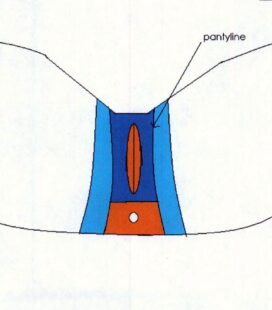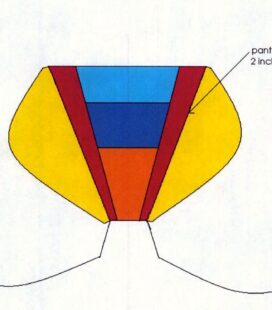Let me start this discussion by saying that, as we see with breasts, labia minora and labia majora come in all shapes and sizes. Choosing to have one’s labia altered is a personal choice.
Requests for labiaplasty, or labia reduction, in Toronto have increased exponentially over the last 10 years and so has the controversy over which technique is better: the trim (some call it trimming) versus the wedge resection.
I have already discussed in previous blog posts the topics of vaginoplasty, perineoplasty and rejuvenation of the mons pubis aka monsplasty.
When discussing labiaplasty of the inner labia, both the trim and wedge excision techniques aim to improve the aesthetics of the inner labia and the discomfort associated with large protuberant labia minora during intercourse.
I will start this blog post by saying that both techniques have excellent results when done by an experienced plastic surgeon. The most important factor is likely the comfort level of your plastic surgeon.
Trim or Trimming
The “trim,” or “trimming,” procedure is technically simpler, and less likely to cause complications and problems during and after surgery. Trimming alone will not reduce the fullness in the clitoral hood unless a horseshoe extension is performed, keeping a healthy distance away from the clitoris. Scars would then be required above the clitoris. That being said, surgery involving thin mucosa often leads to very fine and thin scars.
The trim, or trimming, technique allows for a clean and straight-line type of reduction. It also allows more easily the removal of a large excess of mucosa for ladies with large labia. It also allows the surgeon to achieve the “Barbie” look (aka designer labia) for women aspiring to having no labia minora showing whatsoever between the labia majora, when wearing lingerie or bathing suits.
Some opponents to the trimming technique say it produces a less natural result due to the somewhat straight vertical appearance of the labia minora. The same opponents will also mention that there is a slightly higher chance of dyspareunia, i.e., pain with sexual intercourse, with the trim technique. In my experience, the dyspareunia is rare with both techniques, tends to improve over time, and I have seen this complication with both techniques.
It is true that the wedge procedure will mostly improve the central portion of the labia, but by pulling the mucosa back together after the wedge is resected, it will address and reduce the entire length of the labia minora, along with some tightening of the vagina.
Wedge Excision
The wedge resection technique is more technically challenging for the inexperienced plastic surgeon. It is also a slightly longer procedure as it involves a layered suture-closure.
The wedge excision will keep the delicate labial edge intact.
The wedge excision will also tighten the vagina to some extent, with its internal (vaginal) incision. Care must be given to not make the entrance to the vagina too tight and to protect the urethra by putting a urinary catheter intraoperatively.
The degree of wound opening post-procedure (aka dehiscence) is rare, but might be slightly higher with the wedge excision, as the tension is slightly higher on the closure when aiming at tightening the entire labia minora.
Complications with both techniques include hematomas (large blood collection post-surgery), infection, cyst formation, scar, mucosal retraction, over resection, and pain with intercourse. Post-op hematomas and infections/abscesses would require immediate attention and drainage. As with any surgery, minor problems might require a revision.
Cost will vary according to the technique, the extent of excision, and also the type of anesthesia chosen by the patient and plastic surgeon. Some labiaplasty procedures can be done under pure local anesthesia whereas most are performed with either intravenous sedation with local anesthesia or full general anesthesia.
Recovery will vary slightly between individuals. I use dissolving sutures, which tend to melt over 7–10 days. Swelling can last 2–4 weeks. Bruising is likely, but excessive swelling would require a visit to your plastic surgeon to rule out hematoma (blood collection) or infection. No sexual intercourse for 4–6 weeks.
So, in summary:
Trim labiaplasty pros and cons
1. Simpler and less technically demanding procedure for the surgeon.
2. Removes tissue along the entire length of the labia minora.
3. Does not improve or tighten the clitoral hood in itself. If this is important, the trim can be combined with another procedure to reduce the clitoral hood, with an incision that may or may not be directly over the clitoris (as in the horseshoe technique).
4. Does remove the delicate free margin of the labia minora, which might be an advantage for a patient who does not like that pigmented tissue and wants it removed.
5. May be more effective for very long and enlarged labia.
6. Allows more easily for the Barbie or designer labia “look” for patients who prefer not having any labia minora showing in bathing suits and lingerie.
7. May result in a higher incidence (yet still very low and usually temporary) of dyspareunia (pain with sexual intercourse).
8. Will not tighten the vagina.
Wedge excision labiaplasty pros and cons
1. Does not disrupt or remove the delicate free margin of the labia minora.
2. Can tighten most of the entire length of the labia minora but perhaps to a lesser extent compared to the trimming technique.
3. Will tighten the vagina to some extent — a beneficial feature for some women.
4. Higher risk of urethra injury, but the insertion of a urinary catheter usually prevents this complication.
5. More complex procedure, requiring more skill to reduce the chance of too much tightening of the opening of the vagina or injury to the urethral opening.
In conclusion, when performed by an experienced plastic surgeon, both techniques for labiaplasty are both very satisfactory and can achieve natural results with minimal complications.
Dr. Marc DuPéré, aesthetic plastic surgeon in Toronto












